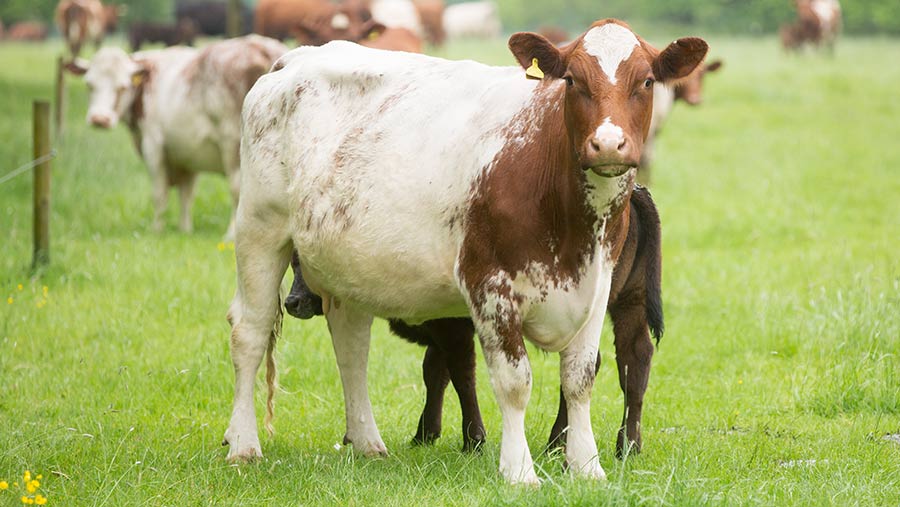Beginner’s guide to measuring suckler herd performance
 © Tim Scrivener
© Tim Scrivener Understanding the performance of a suckler herd is critical for making future decisions and setting targets to improve production and profitability.
One way of measuring this is through Key Performance Indicators (KPIs). These are numerical values that allow producers to set targets and measure against them to analyse business performance. Having a sound understanding of them can help beef farmers make better, more profitable decisions.
Below, farm consultant Rhidian Jones of RJ Livestock Systems, talks through some of the top three KPIs that suckler farmers who are new to recording and monitoring should assess. He also advises how farmers can ensure targets are being met.
See also: 5 minutes with… Beef Farmer of the Year Andrew Laughton
1. Number of calves reared
Why:
The profitability of a suckler herd relies on producing a live, healthy calf. Therefore, the more calves reared, the more profitable the business should be.
How is it calculated?
Number of calves reared is calculated by dividing the number of calves weaned by the number of cows and heifers put to the bull, multiplied by 100.
Target:
Industry standards state a 94% target. However, this can be quite hard to achieve consistently year-on-year, so aiming for 90%-92% may be more realistic initial target.
If I’m not meeting the target, what can I do?
Go back and look at calving records. Have there been any previous fertility issues? Condition at bulling is really important, so think about whether this could be affecting things. Nutrition also has a big impact on fertility, so it is worth sitting down with your vet and nutritionist to discuss where things could potentially be going wrong.
2. Calving spread
Why:
A tight calving pattern highlights good fertility within the herd and – for those breeding their own replacements – gives more choice of earlier-born heifer replacements. These earlier-born offspring are more likely to reach bulling faster.
How is it calculated?
Calving spread is calculated by dividing the number of cows and heifers calved in the first three weeks by the number of cows and heifers put to bull, multiplied by 100.
Target:
Producers should be aiming for two thirds (65%) of cows to calve down in the first three weeks and a further 30% in the second cycle.
If I’m not meeting the target, what can I do?
If calving is spread over 20 weeks, it may be best initially to split the calving into two distinct blocks.
If it is 13-20 weeks then gradually shortening the bulling period can help to bring the calving spread under control as long as all other factors, such as cow condition, health and bull fertility, are favourable.
3. Cow efficiency
Why:
This is a relatively new measure that looks at weaned calf weight as a percentage of the dam. Monitoring via this KPI can help drill down into which are the most productive and profitable cows within the herd.
How is it calculated?
Cow efficiency is calculated by dividing the total weight of calf weaned (adjusted to 200 days) by the weight of cows that went to the bull, multiplied by 100.
Target:
There is no specific target for this, but anything approaching 50% is good – of course, the higher the percentage, the more profitable the cow is.
If I’m not meeting the target, what can I do?
Monitor calf growth up to weaning and also keep an eye on mature cow size to influence culling policy. Culling out any cattle that don’t meet a minimum target of efficiency will help to ensure the overall productivity of the herd.
4 top tips for getting started with KPIs
- Implement a good, central record system
If you cannot measure, you cannot manage, so it is key to keep accurate records. A good starting place is to focus on bulling – keeping a record of heats and conceptions.
Weighing is also a useful avenue for data collection. If you’ve got the facilities, use them. When you’ve got really big beef cattle, you could easily find that estimates are as much as 100kg out.
Calving records are equally as important and should reference the cow ID, calving dates and any calving problems or other issues. Use the standard 1-6 calving score system to rank each birth, with one being no assistance and six being a caesarean.
- Use the data to benchmark
There are lots of online platforms such as Farmbench, Measure to Manage and the Quality Meat Scotland measuring tools which can help farmers get started with simple benchmarking.
Doing this will not only help you to analyse your performance compared with the national herd, but also to compare your performance year-on-year.
- Join a focus group
Wherever you are in the country, there will be a strategic network or monitor farm group that you can get involved in.
This will help you to compare within smaller peer groups and discuss ideas and practices which could help improve performance within your own business.
- Pick out a few important KPIs to concentrate on
Knowing what to focus on and where to start can be overwhelming when it comes to selecting KPIs.
Use the areas of lesser performance highlighted through benchmarking to target specific issues, rather than trying to perfect every area of the business.
